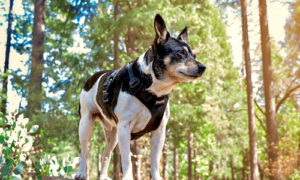
The Weimaraner was once known as the Weimar Pointer and was developed in the early 19th century by nobility associated with the court of Weimar that decided to create one breed with speed, courage, intelligence, and scenting abilities.
The dog’s ancestors include German hunting dogs such as the German Shorthaired Pointer and the Bloodhound. The Weimaraner is a proficient hunter of big game, and they’re also excellent for upland shooting and water retrieving. In Germany, breeding programs were rigorously controlled, and the exportation of the dog was banned for decades. In 1929, an American was finally allowed to join the elite club of Weimaraner owners and given permission to bring two dogs to the United States.
The Weimaraner quickly developed a reputation as a world-class obedience contender, and to this day, it remains a highly sought-after hunting dog and field-trial competitor.

Breed Standard
The breed’s head is moderately long, with the muzzle and skull approximately equal in length. It has amber, gray, or blue-gray eyes, high set ears, and a keen, intelligent, and kind expression. The Weimaraner has a moderately long, level back, a deep chest, and straight, sturdy legs, with firm, compact feet with webbed toes. Its tail is carried confidently and docked to approximately six inches.
Breed Facts

- Activity level: High. The Weimaraner must be built for endurance and speed according to standard. The breed is energetic that requires plenty of room and space to run. The dogs must be exercised in a fenced-in area and will range in search of game. They do exceptionally well in obedience, tracking, rally, hunt tests, and field trials. They’re also great hiking and jogging companions. Without sufficient exercise, the dogs will resort to habits such as chewing and excessive barking.
- Grooming: A weekly brushing is recommended.
- Color: The Weimaraner is solid in shades ranging from silver-gray to mouse gray.
- Coat: Smooth, sleek, and short.
- Group: Sporting
- Year recognized by the AKC: 1943
- Popularity: Popular
- Family group: Gundog, Pointer, Versatile Hunting Dog
- Area developed: Germany
- Date developed: 1800s
- Original purpose: Large game trailing
- Today’s purpose: Pointing, pointing field trials
- Other names: Weimaraner Vorstehund

Weimaraner Temperament
This breed is a sensitive, devoted dog that is highly affectionate towards its family. The Weimaraner is more alert with a strong protective instinct than some other gundogs, making for an excellent watchdog. The dog is brilliant and was bred for versatility, but obedience training is necessary. They have a lot of character and can be headstrong and assertive, so consistent training is recommended. Weimaraners are tolerable of small pets, but caution is always advised.
Health
- Main concerns: gastric torsion
- Minor concerns: spinal dysraphism, CHD, entropion, distichiasis, vWD, hemophilia A, hypertrophic astrophysicist
- Rarely seen: ununited anconeal process, eversion of nictitating membrane, PRA, dwarfism, tricuspid valve dysplasia, persistent right aortic arch, hypothyroidism
- Recommended tests: hip, eye, thyroid, (vWD)
- Life span: 10 to 13 years
- Weight: 55 – 90 pounds
- Height: Male – 25 to 27 inches; Female – 23 to 25 inches

Breeder and Buyer Advice
Before purchasing a puppy, ask to see the mother and verify that the parents have been screened for health issues. Check the dog’s pedigree to determine if the breeder participates in dog shows, field trials, or obedience competitions. Involvement in any or all of these trials is a plus. Also, make sure to get a health guarantee for any purchased puppy.
- Parent club: Weimaraner Club of America (https://weimaranerclubofamerica.org); founded in 1942.
- Regional clubs: You can find information on the club’s website.
- Rescue: Weimaraner rescue




